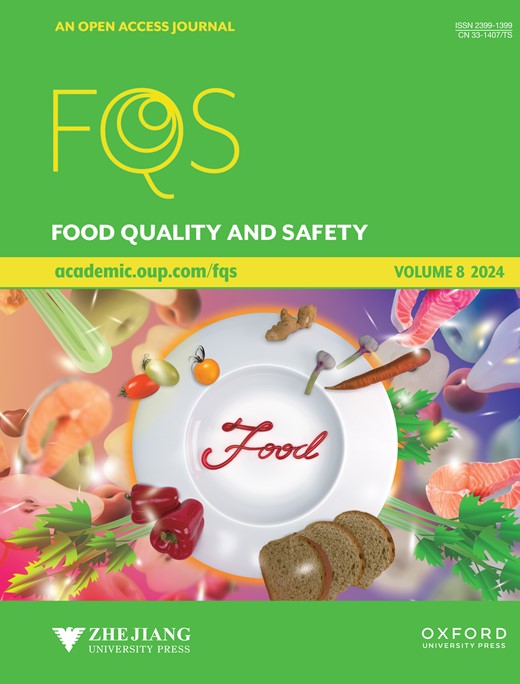Functional genomics reveals functions of terpene synthases for volatile terpene formation in peach
IF 3
3区 农林科学
Q2 FOOD SCIENCE & TECHNOLOGY
引用次数: 0
Abstract
Terpenes are important volatile organic compounds (VOCs) impacting fruit aroma and flavor quality. Terpene synthases (TPSs) are the key enzymes responsible for the biosynthesis of basic backbone structure of terpenes. Here, we show that genome of cultivated peach (Prunus persica L. Batsch) contains 38 TPS genes, with 24 members in the TPS-a cluster. Transcriptome analysis showed that the expression of PpTPSs in peach fruits was regulated by environmental factors such as UV-B light and low temperature, as well as by phytohormones such as ethylene and MeJA. After analyzing the expression of 38 PpTPSs in peach fruit developmental stages and different tissues, we screened and cloned six new highly expressed TPS genes. Subcellular localization showed that PpTPS13 and PpTPS23 were localized in the plastid, while PpTPS12, PpTPS22, PpTPS25 and PpTPS28 were localized in the cytoplasm. Heterologous expression of PpTPSs in Escherichia coli followed by the enzymatic assays revealed that only four TPSs (PpTPS12, PpTPS22, PpTPS25 and PpTPS28) were active in vitro. Using GPP and FPP as substrates, respectively, these PpTPSs were able to synthesize an array of volatile terpenes, including 15 monoterpenes such as geraniol, camphene, pinene, borneol and phellandrene, and 14 sesquiterpenes such as farnesene, nerolidol and α-bergamotene. Our results provide target genes for engineering to enhance production of volatile terpenes and thereby to improve fruit quality.功能基因组学揭示了桃中挥发性萜烯形成过程中萜烯合成酶的功能
萜烯是影响水果香气和风味质量的重要挥发性有机化合物(VOC)。萜烯合成酶(TPS)是负责萜烯基本骨架结构生物合成的关键酶。在这里,我们发现栽培桃(Prunus persica L. Batsch)的基因组中含有 38 个 TPS 基因,其中 24 个属于 TPS-a 簇。转录组分析表明,桃果实中 PpTPSs 的表达受 UV-B 光和低温等环境因素以及乙烯和 MeJA 等植物激素的调控。在分析了 38 个 PpTPSs 在桃果实发育阶段和不同组织中的表达后,我们筛选并克隆了 6 个新的高表达 TPS 基因。亚细胞定位显示,PpTPS13 和 PpTPS23 定位于质体,而 PpTPS12、PpTPS22、PpTPS25 和 PpTPS28 定位于细胞质。在大肠杆菌中异源表达 PpTPSs 并进行酶切实验后发现,只有四种 TPSs(PpTPS12、PpTPS22、PpTPS25 和 PpTPS28)在体外具有活性。分别以 GPP 和 FPP 为底物,这些 PpTPSs 能够合成一系列挥发性萜烯,包括 15 种单萜烯(如香叶醇、莰烯、蒎烯、龙脑和黄柏烯)和 14 种倍半萜烯(如法呢烯、橙花叔醇和α-bergamotene)。我们的研究结果为提高挥发性萜烯的产量从而改善果实品质提供了目标基因。
本文章由计算机程序翻译,如有差异,请以英文原文为准。
求助全文
约1分钟内获得全文
求助全文
来源期刊

Food Quality and Safety
FOOD SCIENCE & TECHNOLOGY-
CiteScore
7.20
自引率
1.80%
发文量
31
审稿时长
5 weeks
期刊介绍:
Food quality and safety are the main targets of investigation in food production. Therefore, reliable paths to detect, identify, quantify, characterize and monitor quality and safety issues occurring in food are of great interest.
Food Quality and Safety is an open access, international, peer-reviewed journal providing a platform to highlight emerging and innovative science and technology in the agro-food field, publishing up-to-date research in the areas of food quality and safety, food nutrition and human health. It promotes food and health equity which will consequently promote public health and combat diseases.
The journal is an effective channel of communication between food scientists, nutritionists, public health professionals, food producers, food marketers, policy makers, governmental and non-governmental agencies, and others concerned with the food safety, nutrition and public health dimensions.
The journal accepts original research articles, review papers, technical reports, case studies, conference reports, and book reviews articles.
 求助内容:
求助内容: 应助结果提醒方式:
应助结果提醒方式:


